
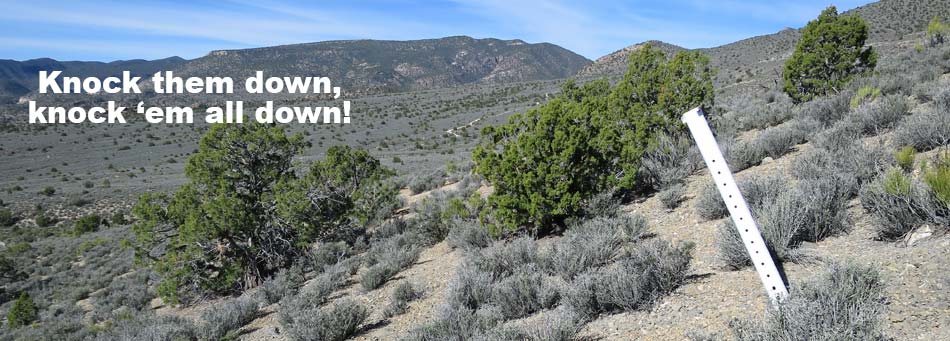
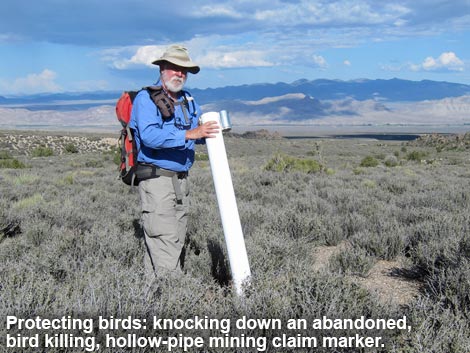 Nevada law empowers citizens to knock down these markers |
Abandoned, Bird-killing, Mining-Claim Markers The Abandoned, Bird-killing, Mining-Claim Marker Knock-Down Project is a cooperative effort between the Bureau of Land Management (BLM), Nevada Division of Wildlife (NDOW), several non-governmental organizations (Audubon Society, Sierra Club, Sonoran Joint Venture), and ordinary citizens to remove hollow-pipe mining-claim markers from public lands in Nevada. Hollow-pipe mining claim markers, used by prospectors from about 1970 to 1990, trap and kill untold numbers of birds, squirrels, bats, lizards, snakes, native bees, and bugs of all sorts. Removing these markers will end this killing scourge in Nevada. I am passionate about this effort, and I coordinate citizen efforts to knock down markers in southern Nevada. I encourage all users of public lands to knock down hollow-pipe mining claim markers, but even more, send me an email and let me know where you see them. I'll get a crew of volunteers out for a Mine Marker Knock-Down Event to find and knock down the rest. |
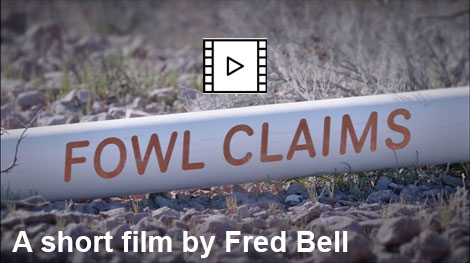 |
Check out this short video (2-1/2 minutes), Fowl Claims by my friend Fred Bell, that describes the problem posed by mining claim markers. For a longer version of the film, see Fowl Claims (12 minutes). The long version has run at several film festivals. |
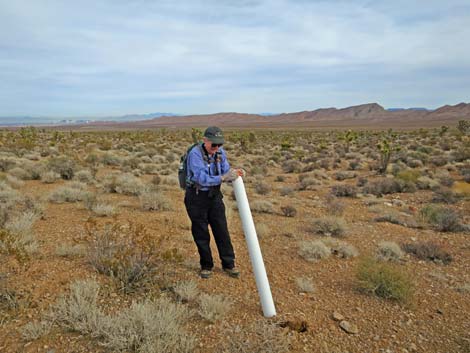 Just grab the pipe and pull it over |
The Problem (see expanded discussion) Prospectors started using these white pipes in about 1970, but by about 1980, wildlife biologists began raising an alarm because these hollow pipes were found to inadvertently trap and kill birds and other small creatures. Some bird species, especially those that nest in old woodpecker holes and similar cavities, would hop down into the pipes to investigate "the cavity" as a place to nest -- never to return. The smooth inner walls of the pipes provide no grip for their claws, and the pipes are too narrow for birds to spread their wings. Unable to escape, birds were left to starve or die of thirst. Other species also get into the pipes, including bats and chipmunks, and surprisingly — native bees by the thousands. Perforated leach-field pipes pose additional threats because the ground-level holes let small creatures fall into the bottom of the pipe. Many beetles, scorpions, lizards, and small snakes have fallen into oblivion. |
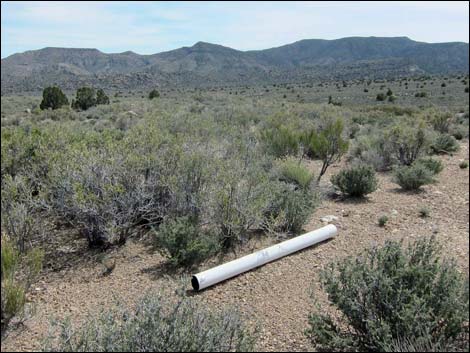 The law says to leave pipes on ground The law says to leave pipes on ground |
Nobody knows how many birds die this way every year, but estimates are high. Not every marker contains dead birds, but counts as high as 100 have been recorded (6-10 dead birds per pipe is common in southern Nevada; the numbers are lower in middle Nevada). With about one million hollow-pipe markers across the western United States, the annual number of deaths must be large. Personally, I've twice found 35 dead birds inside a single marker (mostly Ash-throated Flycatchers). In addition to birds, I've found dead bats, lizards, snakes, mice, chipmunks, scorpions, beetles, tarantula hawk wasps, caterpillars, darkling beetles, butterflies, thousands of bees, flies, and other insects. Birds I found dead include Ash-throated Flycatcher, Western Bluebird, Western Screech Owl, House Finch, Northern Mockingbird, Ladder-backed Woodpecker, Black-tailed Gnatcatcher, Black-throated Sparrows, European Starling, Canyon Wren, and Rock Wren. |
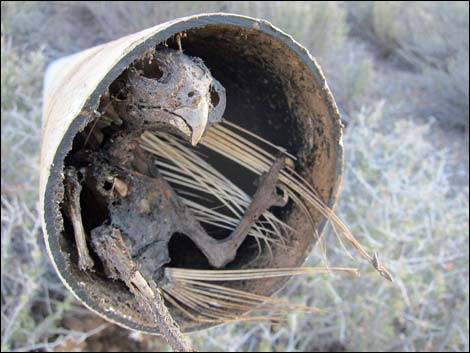 Dead Western Screech Owl inside a hollow-pipe mining claim marker |
The Law In 2009, Nevada Law changed to prohibit hollow mining claim markers. This law also required claim owners to retrofit or remove hollow markers. It also raised the annual fee from $10 to $100 per claim (now $155/yr). Following BLM regulations (PDF 1 MB), owners of real claims retrofitted their markers by replacing them with wooden or metal posts, or simply by putting a cap on the original, non-perforated PVC pipe. Perforated pipes are always illegal -- cap or not. Over vast swaths of Nevada and other western states, speculative claim owners simply walked away and abandoned their claims leaving the bird-killing hollow pipes upright and scattered across the landscape. People are now permitted by Nevada Law to knock these abandoned markers down, ending forever their ability to quietly kill untold numbers of birds and other species. |
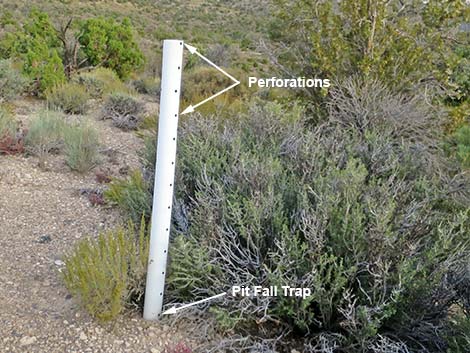 Perforations allow small creatures to fall into the bottom of the pipe |
Some of the pipes used for mining claim markers in the 1970s-1990s were 3-inch diameter, PVC leach-field drain pipes. As such, these pipes are perforated to allow sewage to leach into the soil. Prospectors installed these pipes by digging a hole in the ground, putting the pipe in the hole, and back-filling around the pipe. Installed this way, the bottom of the pipe is not filled with dirt. Inadvertently, perforated pipes then create pit-fall traps where small creatures of all sorts crawl through ground-level holes, fall into the 8- to 10-inch-deep pit, and never get out. |
Note: All distances, elevations, and other facts are approximate.
![]() ; Last updated 240330
; Last updated 240330
| Copyright, Conditions, Disclaimer | Home |